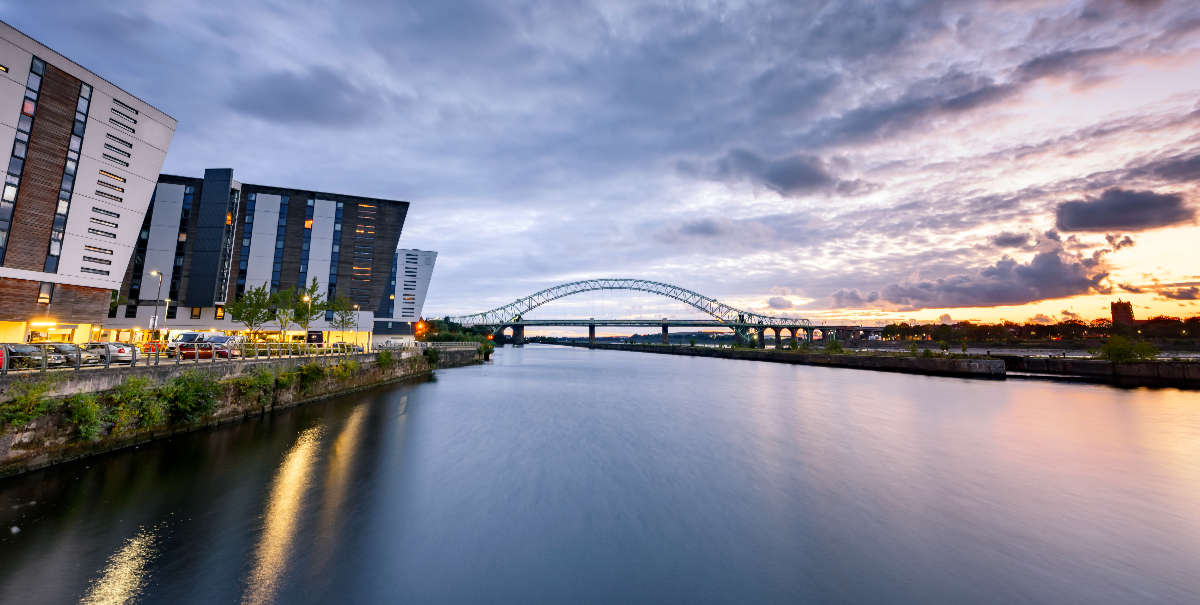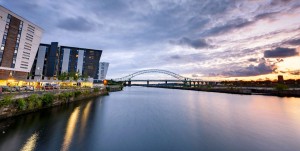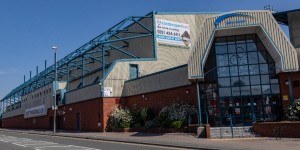
Widnes in Cheshire a Township like no other.
The first thing we read about Widnes was that it was flat, open country, devoid of anything beautiful… and we immediately got a little defensive. There’s a gorgeous river running through town, there are red sandstone boulders and natural clays around town, and there are plenty of farms out in the open country.
Widnes is an often forgotten, overlooked, and a little neglected, area of England. Like many areas in the north, the farther you are from London the less impact your taxes seem to have. Widnes is one of those towns, settled on moorland and marshes, where industry thrives, and they struggle to attract tourism.
This is exactly why you should go there.
Join us, as we take a thorough look at this seemingly overly industrialised township. We believe there is more to Widnes than factories and smoke. If not, then why do people stay there? Let’s find out.

Image: SAKhanPhotography/Shutterstock.com
The Early days of Widnes
Back in the beginning, before the factories moved in, Widnes was reportedly a tiny village on the edge of a marsh. You can imagine that disease would have spread easily, that there was little to do and that there would have been a near-constant struggle for wood and building materials.
Originally a small settlement called Appleton, this town was once under the Barony of Widnes and belonged to the Lord of Halton, which was the largest town in the Hundred of Bucklow. The town existed already in 1066 when the Normans invaded. There aren’t many records of the area before then, so let’s start by jumping in at the Domesday Survey and seeing what was recorded as being on the land where Widnes now stands.
The Domesday Survey was ordered in 1086 by William the Conqueror, the invading Norman who won England as his prize. He wanted to know what it was that he had captured, as well as how much it was worth. He sent his taxmen around the country, to record everything that they saw. Essentially, it became the first map of its kind in England. Part census and part accounting, this is a sort of ordinance survey geared towards making sure King William knew what he had invaded.
The Doomsday Book
You can check your town or city in the open Domesday Survey resource online. This allows you to see what was in your area, back in 1086. For Widnes, it is noted that the town was still called Appleton, Cheshire, as opposed to Widnes – which was the name of the barony area right up until the 10th century and the industrial revolution.
In 1086, Appleton/Widnes was run by Lord Osbern, Son of Tezzo. If you are thinking that those names sound strange for Englishmen, then you are right. Osbern was awarded the land by the king after the invasion, likely for doing a good job with all that killing. In 1066, the land was owned by one Dot of Huyton. It had four ploughlands and not much else. There was half a league of woodland and no men to work the ploughlands. No slaves are recorded, at least. The land was worth 16 shillings but was wasteland both before and after the invasion.
The only other evidence we have of early life in Widnes is in a flint arrowhead that was dug out at the quarry on nearby Pex Hill. The Vikings would also have stopped in this area, lending their axes within the farthest reaches of the Danelaw controlled lands.
It is thought that the town was named by the Danish, who called it Vidnoese. This translates to ‘wide nose’, which would have been a jab at the way the river runs through the land. If there was a town built on a river after the Viking invasions, it is likely that they named it and settled on it. Even the marshes of England were better than the rocky, craggy lands of the Danes.
The Medieval Era in Widnes
The river Mersey, on which the town sits, would once have been part of the Saxon kingdom of Mercia, but we don’t know if it was occupied then. We do know that the Norman’s built a church in the area, circa 1180. We also know that the same church was upgraded in 1500 to become the South Chapel. In 1507, the Bishop sprung for a local Grammar School.
Right up until the Industrial Era, the town was one of several local, sleepy, and rural settlements. There would have been the Farnworth, the Appleton, the Ditton, Upton, Woodend, and ever two villages known as Cronton and Cuerdely. All these areas were eventually swallowed by Widnes, one way or another.
For the next 2-3 hundred years, Widnes was a region filled with marshes, trees, and few people. In 1750 something, the Sankey Canal was built to flow through town, connecting the area to the world of Industry. Later, the canal would be upgraded, and extra connections made.
In the early 19th century, the railway rolled through, connecting a ferry terminal known as Widnes Dock to the rest of the world. This was the first-ever railway port to have been opened anywhere on the globe… and it started the name of ‘Widnes’ to go with the port. People didn’t go to Appleton, or Woodend, or Farnworth after that… they went to Widnes to catch the ferry and so the name stuck.
That’s a pretty heavy lump of history to digest already, so before we get torn into the Industrial age of Widnes, let’s take a breather for some fun facts.
Top Trivia about Widnes
In this section, we like to detail some of the most interesting things to have happened in an area. When it comes to Widnes, we weren’t disappointed – despite being told it was an industrial town and not much else. Here are the Five Minutes Spare favourite fun pieces of trivia about Widnes for you to bring out when you are stuck for conversation:
- Widnes is somewhat famous for its artificial island – “Spike Island” the place where the British Chemical Industry pretty much began.
- It is famous for its smells… and that is not a good thing. According to the Liverpool Echo, they are putting the smells down on a unique map. In 2018, the Environmental Agency went in to investigate. Nobody has heard from them since.
- Even the Guardian reports have gotten in on the Widnes Smells game. Stuart Turton said it was famous for its smell and that on bad days it would punch you in the nose.
- Paul Simon, author of the charming kid’s film “Homeward Bound” apparently wrote a lot of the book from the station platform.
- Widnes had such a bad reputation in the 80s and 90s that people fled once they had grown up.
- The golf club was once closed because arsenic bubbled up from underneath. The swampy marshes contain more than just water and frogs, now that there have been chemical plants in the area for so long… you know that bit in the Simpsons with the four-eyed fish…? That.
So, all in all, Widnes doesn’t sound like a place you would visit for a staycation. However, it is a great base if you want to vacation in Liverpool, without the high price tag.
The Industrial Revolution in Widnes
The Industrial Revolution started off quietly in sleepy Widnes. It was a small port town and not much more than that, right up until 1847. A man named John Hutchinson built a chemical production plant in the area, designed to make Alkalis. There was nothing around for miles other than a few settlements too small to be villages, and Spike Island seemed the perfect place to produce his chemicals. There were so few people and all the supplies he needed could be shipped in. He established his factory first but was quickly followed by a dozen other entrepreneurs in the world of factories, chemicals, and industry.
Farnworth was swallowed first, housing factory workers to the point that it spilt over into the ever-growing port of Widnes. Appleton was next, closely followed by Ditton and Upton. The small settlement of Woodend became the West Bank area of the town. To begin with, the main industries revolved around soap, borax, soda and bleach powder were all made here. By the end of the Industrial Revolution, iron and copper works were also smelting away in town.
By the turn of the 19th century, the whole region was suffering intensely from pollution. The river, port, and lands were all saturated with the produce and offcuts of the chemical industry. In a book written about the living conditions in 1897, the town of Widnes was dirty, ugly, poisonous, and polluted. The author remarked that the spring never arrived. There was nothing in Widnes that was not rotting away as a result of the chemicals in the air.
Immigration
Worse than the horrendous pollution was the nastiness that grew here. By the 1880s, Brits had decided they would no longer put up with these kinds of working conditions. The factory owners responded by bringing in cheap Polish and Lithuanian workers to replace those that protested too loudly. Thus, the English adage that foreigners are stealing their jobs, was birthed here.
By 1890, the chemical industry went into decline. The industries in town that were all involved in the sector, decided to amalgamate to stay alive. It didn’t work, and many factories closed down. This left a town that had grown to massive proportions, now with few places to work. In 1905 it was heavily polluted, dirty, and ugly.
In the early part of the 20th century, the town was gradually improved by the local council. The Transporter Bridge was added in 1905, bringing new industry to the area. In 1909 the town became the first to have covered double-decker buses and we suspect it had something to do with the smells.
By 1950, there were only 50 working chemical factories in a town that had lost many of its young men between two world wars. The council attempted to erect housing estates big enough to hold everyone, but most of the slums that had arisen in the 19th century weren’t properly dealt with until after WWII. The town avoided major bombing in the war, but a German pilot was intercepted on its way home from bombing Liverpool and was shot down to land in a nearby field.
Widnes In the 21st Century
As of the year 2000, the world has been taking a much harder stance on areas exactly like Widnes. Where we once allowed this pollution to continue, we now don’t put up with it in the first place. As such, we can bet that the next few generations of this town will be smarter than the last few. At least in climate terms. The health of the people has improved and some of the land originally scarred as a chemical wasteland has been reclaimed by nature. Let’s hope this trend continues for many years to come.
Now that we have concluded the history section, let’s look at some nicer aspects of life in Widnes. Let’s start with celebrities and how likely you are to meet one in the supermarket.
Famous People from Widnes
You don’t have to look very far for a famous face when strolling the streets of Widnes! Rather, you will find many famous people at the supermarket. The thing about people from Widnes is that they don’t tend to stay there. We have said it about other places before but this time, we really mean it. Widens is somewhere you come from, rather than somewhere you move to.
Some of the famous faces born in the area include:
- Richard Bancroft, who was once the Archbishop of Canterbury and one of the most famous men in England.
- David Dawson, an English actor who played King Alfred in the Last Kingdom, the Netflix adaptation of the Bernard Cornwell series.
- Many of the early chemists were based here and did some ground-breaking work. As much as it polluted the landscape, it was a necessary step in the evolution of chemistry to less invasive means. The Gaskell family produced several factory owners, but there were several others. Chemists don’t get the recognition that they used to.
- Natalie McCool, the singer/songwriter and pals with Coldplay, is from here.
- Literary critic and author Angela Topping is from Widnes.
So even though it is an industrial wasteland nowadays, there are still a load of famous people that are proud to call Widnes their home. Now we are getting to the area of this article that we get excited about… the attractions… we really hope there are some.
Widnes Attractions
In this section we have covered all the best bits of Widnes, to try and give local tourism a boost. It doesn’t smell anymore, we promise. They sorted that out in the early 00s.
Historic Sights and Landmarks
Widnes Market is an outdoor/indoor attraction, dating back to 1875. Boasting a history longer than 140 years, this awesome little market is a more historic attraction than it is a shopping destination. You will find meats, cheeses, and other local produce. You will find clothes, bootleg DVDs and the odd lurker… but it will be fun if you consider it to be an adventure.
Galleries and Museums
The Catalyst Science and Discovery Museum is the best in the area, by far. It is one of those museums aimed at kids, with loads of interactive exhibits they can play with. They are going to switch to a book in advance model for 2021, so be sure to call ahead. The museum teaches us all about the chemical industry and how it impacted the town, but it does it in a fun and engaging way.
Weirdly, Widnes are enormously proud of their rugby team, which win often. They have a Widnes Vikings rugby museum here, for all you die-hard fans.
Outdoor Attractions
You can take the kids to Victoria Park, which is near the town centre. There is a brightly coloured outdoor play area, there are picnic benches, and there are also dog walkers. It’s a pleasant place to spend your lunch break if you work in the town centre, and it allows for a pleasant urban outdoor space where everyone can go to sunbathe on hot days.
If you fancy a nature walk with multiple choices in paths to take, visit Pickerings Pasture. This national park is a wildlife access area for most of the town. You have a great view of the bridge, wildflower meadows, and access to the Upper Mersey Estuary. It’s a Green Flag award-winning area, so you know it will be beautiful.
Another area of conservation and cultivation is Spike Island. Historically home to a chemical plant and various other industrial factories, it now holds nothing but birds, trees, and the odd boat. Take a hike around it and see for yourself.
Sports and Recreation

Graeme Lamb/Shutterstock.com
Widnes Vikings are the stars around this town. They are a rugby league club who can be found playing in the DCBL stadium. You can watch a match, take a tour, or book an event space with class. If football is your sport, there is the Widnes Football Club for you to support. They are part of the Northern Premier League. Go and cheer them on at the weekends to feel the euphoria of the stadium.
Alternatively, take advantage of a local golf club. Choose from the Widnes Golf Club or the Mersey Valley Golf & Country Club. Both will feed your need for golf.
Shopping and Retail
Asides from the Widnes market that takes place every week, you should be able to shop in many a store in Widnes. Some of the best places to get your retail fix include the Green Oaks Shopping Centre, a real-life Albert Square packed with town centre retailers, and the Widnes Shopping Park, which has a Marks and Spencer.
Other Notable Widnes Attractions
There are so many attractions in Widnes (believe it or not) that we had to put in this extra section to catch the overflow. If you are in town for any longer than a day or two, try out some of the following ideas of other notable attractions in and around the Widnes area:
- There are a few statues to track down around town. The Gladstone Memorial Fountain is beautiful in summer and the War Memorial is there for those that want to pay their respects.
- There are a few churches in town, including the spires of St Michael And St Thomas and St Paul’s Church.
- Visit Planet Ice and get your skate on then catch a movie at Reel Cinemas.
- Take the kids to Velocity in Widnes to enjoy some games and entertainments.
As you can see, there is more to this town than meets the eye. There are 80,000 people, for a start, and a whole bunch of great fun to be had. Take your time, go see the sights. The Lord knows that they need the support.
How to get to Widnes?
Now you know all of what we do, except how to get to the town. Asides from going to Manchester and asking a northerner for directions, here’s how you get to Widnes.
By Road
Head west out of Manchester on the M62 and you will arrive in Widnes after you pass through Warrington.
By Rail
Widnes Railway Station is on the northern line.
By Air
You are a hop, skip, and jump, from Liverpool John Lennon Airport.
By Sea
Pull into Runcorn Docks if you are visiting by sea.
Five Minutes Spare
Here at Five Minutes Spare, we regularly review towns and cities, in the hopes of pointing out all the best bits. We review foreign destinations too: but the British tourism industry needs the help. If you can’t go visit the towns in person, you can at least read about them on our website. You can do your part by following us on social media, too.

